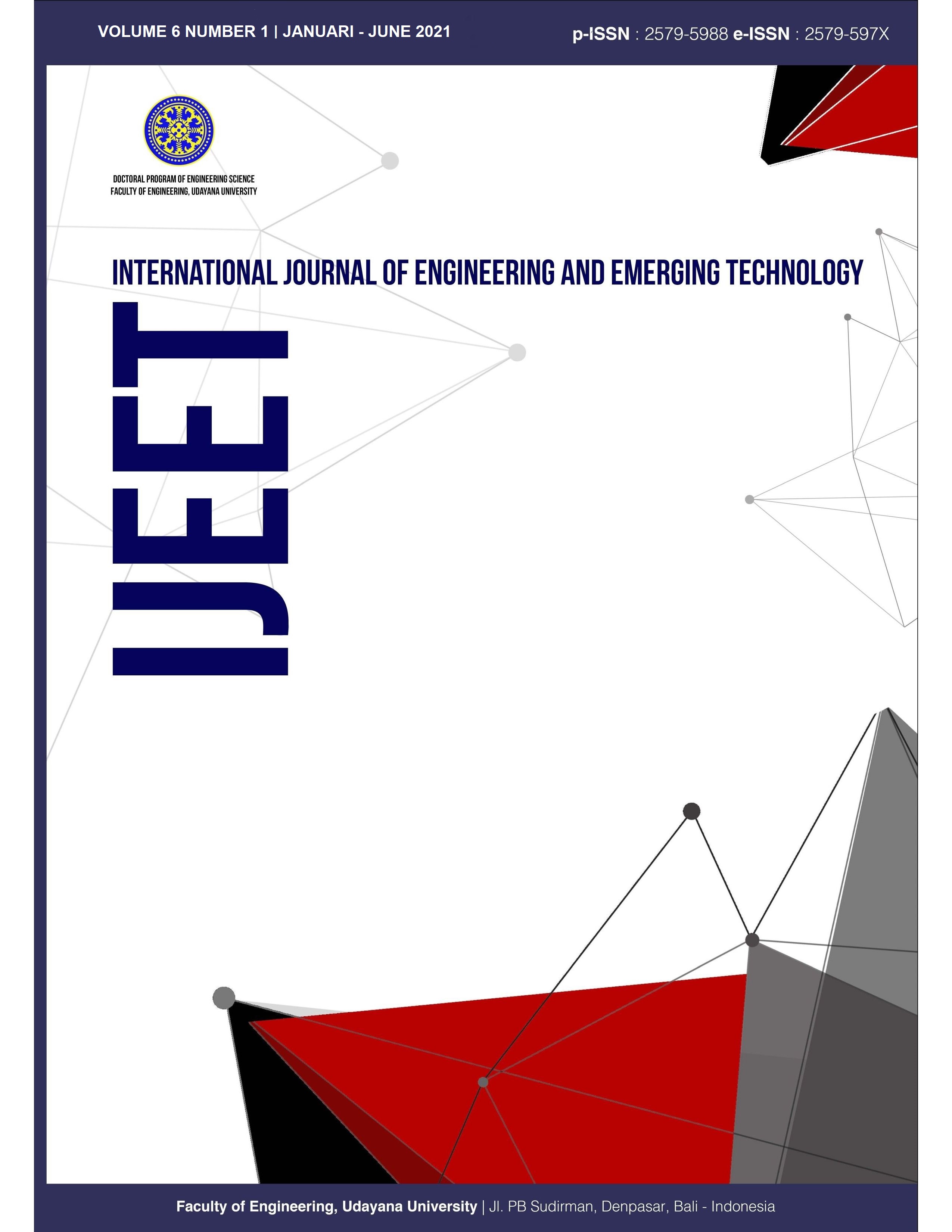Preliminary Study of Green Material for Green Building in Bali
Abstract
The definition of green materials is building materials that are environmentally friendly, do not have a negative impact on building users, and are sustainable. Green Material is one of the criteria in the green building assessment parameters that will support energy efficiency goals. Understanding green materials and their availability for their demands in Bali is important to align the growth of green buildings in Bali with the potential and problems of material supply. This paper aimed at conducting an initial preliminary study of the limitation and opportunities for the use of sustainable building materials according to the green building principle approach in Bali. The method used is descriptive method that is reinforced by literature review techniques related to the context of the discussion . Buildings in Bali, when viewed from the use of building materials, carry very distinctive design and appearance characteristics. The selection of green materials in Bali will be influenced by the demands of the requirements for implementing Balinese architecture in buildings, restrictions on material procurement due to location, material legality references and ecolabel certification documents and opportunities for using smart and advanced materials without losing the character of Balinese building architecture.
Downloads
References
[2] J. Kim and B. Rigdon, “Qualities , Use , and Examples of Sustainable Building Materials,” Building, no. December 1998, 1998, [Online]. Available: http://scholar.google.com/scholar?hl=en&btnG=Search&q=intitle:Qualities+,+Use+,+and+Examples+of+Sustainable+Building+Materials#1.
[3] B. K. Nguyen and H. Altan, “Comparative review of five sustainable rating systems,” Procedia Eng., vol. 21, no. 0, pp. 376–386, 2011, doi: 10.1016/j.proeng.2011.11.2029.
[4] M. Chehrzad, S. M. Pooshideh, A. Hosseini, and J. M. Sardroud, “A review on green building assessment tools: rating, calculation and decision-making,” in The Sustainable City XI, 2016, vol. 1, no. Sc, pp. 397–404, doi: 10.2495/sc160341.
[5] R. Reed, A. Bilos, S. Wilkinson, and K.-W. Schulte, “International Comparison of Sustainable Rating Tools,” JOSRE, vol. 1, no. 1, pp. 1–18, 2009, doi: 10.1515/9781400827688.1.
[6] Green Building Council Indonesia, Perangkat Penilaian GREENSHIP (GREENSHIP Rating Tools), no. April. 2013.
[7] W. Sujatmiko, Z. Astuti, B. N. Raharja, and F. Harijani, Sistem Rating Bangunan Gedung Hijau. Pekerjaan, Kementerian Dan, Umum Rakyat, Perumahan Penelitian, Badan Pengembangan, D A N Litbang, Pusat Dan, Perumahan, 2013.
[8] N. K. A. Dwijendra, Arsitektur Rumah Tradisional Bali - Berdasarkan Asta Kosala-kosali, no. March. 2010.
[9] Peraturan Menteri Pekerjaan Umum, “Pedoman Persyaratan Teknis Bangunan Gedung,” 2006.
[10] Shiva,Ji, “Green Building Materials and their Common Use in Everyday Life,” no. January, pp. 0–30, 2016, doi: 10.13140/RG.2.1.1635.4323.
[11] D. R. Syahriyah, “Penerapan Aspek Green Material Pada Kriteria Bangunan Ramah Lingkungan Di Indonesia,” J. Lingkung. Binaan Indones., vol. 6, no. 2, pp. 95–100, 2017, doi: 10.32315/jlbi.6.2.95.
[12] M. Mahmoudian and P. Sharifikheirabadi, “Uses of New/Smart Materials in the Green Building With Sustainability Concerns,” Int. Trans. J. Eng. Manag. Appl. Sci. Technol., vol. 11, no. 3, pp. 1–12, 2020, doi: 10.14456/ITJEMAST.2020.56.
[13] A. Singh, S. I. Olsen, and D. Pant, “Importance of life cycle assessment of renewable energy sources,” in Green Energy and Technology, 2013.
[14] K. I. Vatalis, O. Manoliadis, G. Charalampides, S. Platias, and S. Savvidis, “Sustainability Components Affecting Decisions for Green Building Projects,” Procedia Econ. Financ., vol. 5, no. 13, pp. 747–756, 2013, doi: 10.1016/s2212-5671(13)00087-7.
[15] G. A. M. (ed) Suartika, Vernacular Transformations : Architecture, Place and Tradition, 1st ed. Denpasar, Bali: Pustaka Larasan, 2013.
[16] I. N. Gelebet, I. W. Meganada, I. W. Y. Negara, I. M. Suwirya, and I. N. Surata, Arsitektur Tradisional Daerah Bali. Proyek Inventarisasi dan Dokumentasi Kebudayaan Daerah, Departemen Pendidikan dan Kebudayaan, 1982.
[17] K. P. U. dan P. Rakyat, “Peraturan Menteri No.02/PRT/2015 tentang Bangunan Hijau,” 2015.
[18] K. P. U. dan P. R. Dinas Cipta Karya, “Petunjuk Teknis Penyelenggaran Bangunan Hijau,” 2016. [Online]. Available: http://www.pu.go.id/.
[19] Pemerintah Daerah Propinsi Bali, Peraturan Daerah Provinsi Bali Nomor 5 Tahun 2005 tentang Persyaratan Arsiitektur Gedung, vol. 1, no. 1. 2005, pp. 1–8.
[20] K. D. Dinas Pekerjaan Umum, “Peraturan Walikota Denpasar Nomor 25 Tahun 2010 Tentang Persyaratan Arsitektur Bangunan Gedung di Kota Denpasar.” p. 13, 2010, [Online]. Available: http://perijinan.denpasarkota.go.id/peraturan/file_peraturan/PerwaliNomor25Tahun2010.pdf.
[21] M. L. H. dan K. R. Indonesia, Permen No.P.42/Menlhk-Setjen//2015 tentang Penatausahaan Hsail hutan kayu yang berasal dari hutan alam. 2015.
[22] M. Bauer, P. Mösle, and M. Schwarz, Green building: Guidebook for sustainable architecture. 2010.
[23] I. W. Gomudha, “Rekonstruksi Dan Reformasi Nilai-Nilai Arsitektur Tradisional Bali (ATB) Pada Arsitektur Masa Kini ( AMK) di Bali,” 2000. [Online]. Available: https://simdos.unud.ac.id/uploads/file_penunjang_dir/8ddf0d828e6fb789f454a0fe010ca28f.pdf.

 Indexed By
Indexed By







